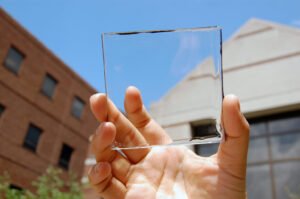Korean Scientists Crack the Code: Solar Panels You Can’t Even See!
In busy cities, space is precious. Rooftops are full, open land is limited, and using renewable energy is a big challenge. Regular solar panels work well, but they need space that many buildings don’t have. But what if the glass around us—windows, tall buildings, and even phone screens—could produce electricity without changing their look?
Transparent solar panels can do exactly that. This new technology allows glass to generate power while staying clear. It solves the problem of space and fits perfectly with modern buildings. This isn’t just a new idea—it’s a big step toward a future with clean energy.

In 2014, scientists at Michigan State University (MSU) created the first fully clear solar panel. This was a major breakthrough. Unlike regular panels, this one collects invisible light, like ultraviolet and infrared rays, while letting visible light pass through. The invisible light is sent to thin solar strips at the edges, which then convert it into electricity.
Since then, researchers have worked hard to make the technology better. The first versions were only 1% efficient, but now they reach nearly 5%, with hopes of going even higher. According to Richard Lunt, a lead researcher at MSU, these panels could turn any glass surface—from windows to phone screens—into a power source, changing the way we use solar energy.

Korean scientists at Incheon National University have made an exciting new discovery: a fully transparent solar cell. Led by Professor Joondong Kim, this research shows how smart materials and creative design can bring us closer to a clean energy future.
Their design focuses on a key part of solar panels called the heterojunction, where light turns into electricity. By using titanium dioxide (TiO₂) and nickel oxide (NiO), both eco-friendly materials, they created a system that absorbs invisible UV light while keeping the glass clear. This allows the panel to produce electricity without blocking light.
Five years after the Paris Climate Agreement, the world is moving quickly toward clean energy. Solar power is one of the best options, but regular panels are opaque, so they are mostly placed on rooftops or in large solar farms. Transparent solar panels are different—they can be built into windows, buildings, and even small devices like smartphones, making clean energy more accessible.
Titanium dioxide is already used in many solar panels because it’s great at absorbing UV light and is safe for the environment. Nickel oxide is another important material—it’s clear, easy to produce, and abundant on Earth. Together, these materials create an efficient and eco-friendly way to generate electricity.
Professor Kim explains, “Transparent solar cells could have many uses in modern technology.” From buildings to smart devices, these panels could help power the world. This breakthrough isn’t just an improvement—it completely changes how we think about solar energy.

While this technology is promising, there are still challenges to overcome before it becomes widely available. Researchers are working hard to solve these problems so that transparent solar panels can be used on a larger scale.
One major challenge is cost. Right now, producing these panels requires advanced materials and precise techniques, making them more expensive than traditional panels. However, as production increases, prices will likely drop, making them more affordable.
Another challenge is efficiency. Transparent panels don’t absorb as much light as regular ones, which means they produce less electricity. Scientists are trying to improve this by using better materials like perovskites and titanium dioxide, which can boost efficiency while keeping the glass clear.
Despite these challenges, the potential impact of transparent solar panels is huge. They can turn everyday glass into a power source, making them perfect for crowded cities where space is limited.
Looking ahead, this technology is about more than just energy—it’s about changing the way we build our world. Imagine cities where windows power buildings, devices that charge themselves, and glass that helps fight climate change. With continued research and investment, transparent solar panels will play a major role in achieving a clean-energy future.
Transparent solar panels aren’t just a cool idea—they’re a real solution to energy problems. Think about it: windows, phones, and skyscrapers generating power without anyone noticing. This technology isn’t just about saving space—it’s about combining beauty and sustainability in a way that fits naturally into our lives.
Of course, there are still obstacles. Efficiency needs to improve, costs need to go down, and production needs to scale up. But that’s how all great inventions start—with small steps that lead to big change. Transparent solar panels prove that when we think outside the box, we find solutions hidden in plain sight.
The future of solar energy doesn’t have to be loud or obvious. It can be silent, clear, and revolutionary. These panels show that the answers we need are already around us—we just have to be willing to see them. The only question is: are we ready to take the next step?
